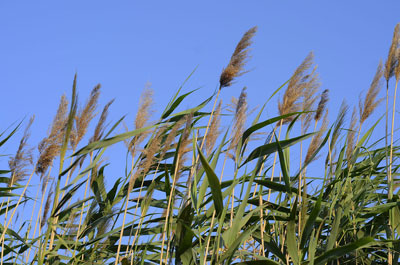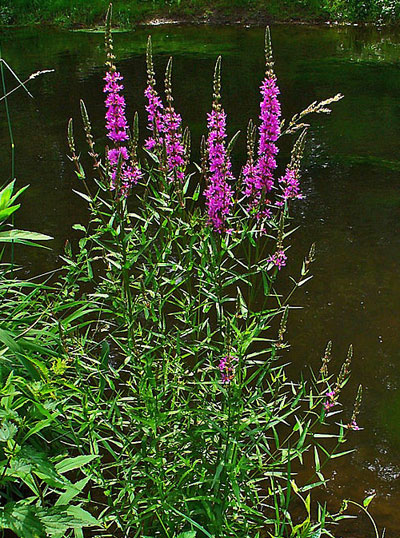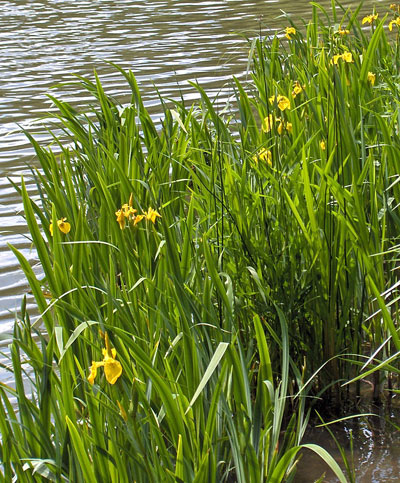INVASIVE SPECIES AT ROSELAND LAKE
ALSO SEE: Aquatic Plants | Vegetation
INVASIVE PLANTS
Phragmites, Purple Loosestrife and Yellow Flag pose a serious threat at Roseland Lake. Invasive plants may be attractive, but they quickly choke out communities of native plants, reducing biodiversity. They form impenetrable thickets, which reduces wildlife habitat and cover. They eliminate natural food sources for marsh creatures. They also change hydrology, changing flow patterns and impacting wetlands function.
See this excellent pictoral guide to CT invasive aquatic and wetland plants prepared by the CT Ag Experiment Station
- Phragmites australis (Common Reed or Reed Grass): Phragmites spreads about 3-5% a year. If one plant bends over, it can send out runners 30-50 feet long, which sprout at every node.
A Phragmites control project began in 2003 at Roseland Lake, in the Muddy Brook/Little River sub-regional watershed of Woodstock. This project reduced the invasive non-native wetland plant by nearly 95%. The project was conducted by the CTDEP Wetland Habitat Management Program.
A third year of Phragmites removal was conducted in 2005 and the project was deemed a success in removing nearly all Phragmites stands along this water body. Continued outreach will continue to engage local stakeholders in ongoing monitoring and management. [Source: CT DEP Nonpoint Source Management Program, 2006 & 2007, page 38]
The Connecticut DEEP returned to Roseland Lake to control Phragmites on September 9-10, 2014. Plants were sprayed with a product containing imazapyr as the active ingredient. Imazapyr shuts down the plants ability to make food, so the plant uses up its reserves and eventually starves itself out. This takes about 4-6 weeks. Burning is no longer done in CT due to fire risk. Homeowners can regularly brush cut Phragmites to prevent spread.
- Lythrum salicaria (Purple Loosestrife): Purple Loosestrife is becoming increasingly common in wetlands and along roads in Woodstock. Numbers on the shorelines of Roseland Lake increased noticeably in 2014. See management options from the CT Invasive Plant Working Group, which include hand pulling, cutting, mowing, biological controls, and glyphosate (Roundup and Rodeo).
- Iris pseudacorus (Yellow Iris/Yellow Flag/ Water Flag / European Yellow Iris): Clumps of Yellow Iris are spreading fast on both sides of Roseland Lake. See management options from the CT Invasive Plant Working Group, which include pulling and hand digging plants, removing all rhizomes (wear gloves as resins in the leaves and rhizomes can be irritating), and dead heading them after blooming to prevent seedpod development. If herbicides are used, cut the stems off and apply the appropriate, permitted herbicide to the stump.
- ? Myosotis scorpioides, True or Common Forget-me-not: A low-growing perennial. Flowers are flat and typically blue with a yellow "eye," and oblong, lance-shaped leaves. Chunks that break off will root elswhere. Forget-me-notes are growing along the banks of Muddy Brook, but I'm not sure if they are M. scopioides, M. sylvatica or M. laxa.
- Aquatic Invasives: A 2012 survey did not identify any aquatic invasive plants in the lake. This was good news, because invasive milfoil has been seen upstream of Roseland Lake. However, boaters, paddlers and anglers could introduce aquatic invasives if they are not careful. Read more.
- Euonymus alatus (Thunb.) (Burning Bush/Winged Euonymous): Burning Bush is a real problem in upland areas. Unfortunately, this invasive ornamental plant was not banned (and was still sold by local nurseries) in CT until very recently.
- Invasive Honeysuckle, Asian (oriental) Bittersweet, and Multiflora Rose are also prolific along the banks of Muddy Brook.
- Japanese Stiltgrass (Microstegium vimineum) is spreading in the area. More info.
MORE INFORMATION
 |
| Phragmites. Wikimedia commons photo. |
 |
| Purple Loosestrife. Wikimedia Commons photo. One Purple Loosestrife plant can produce over 2,000,000 seeds |
 |
| Yellow Iris. Wikimedia Commons photo |